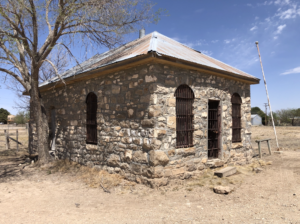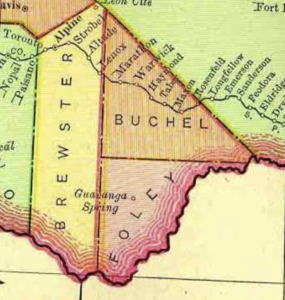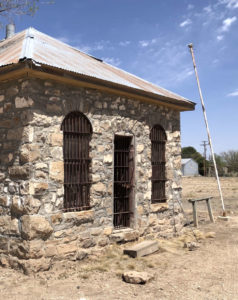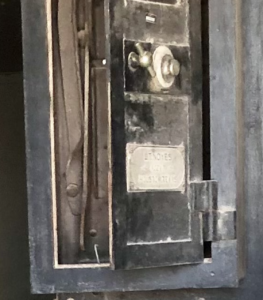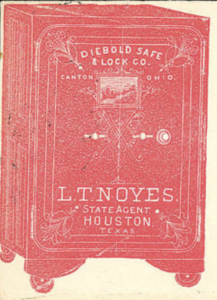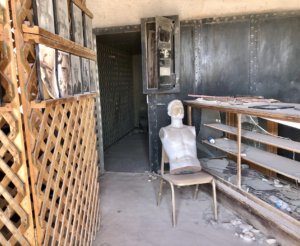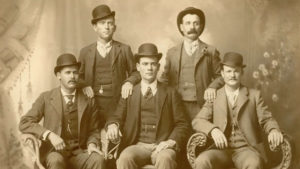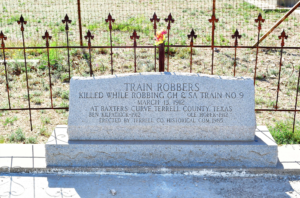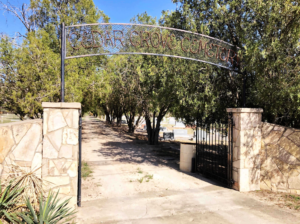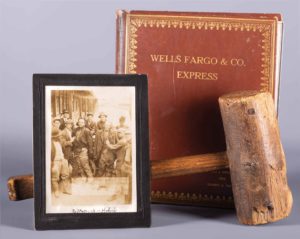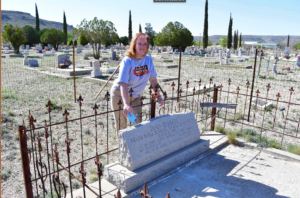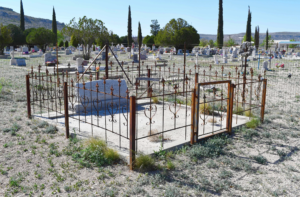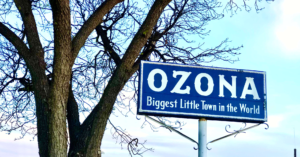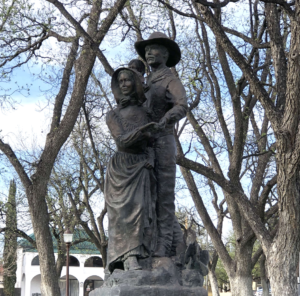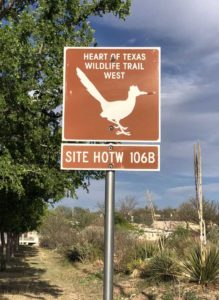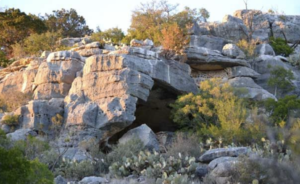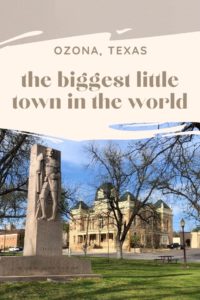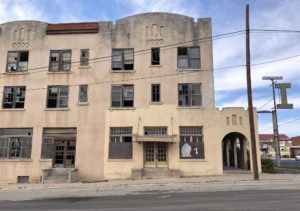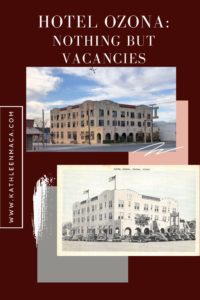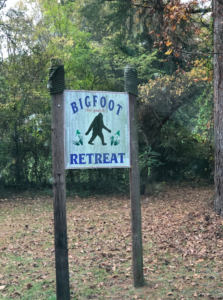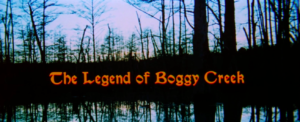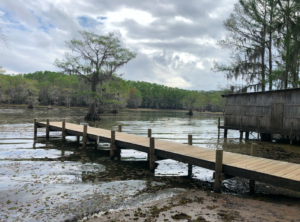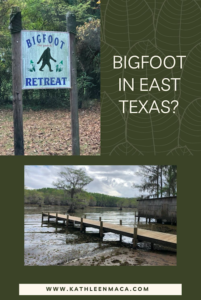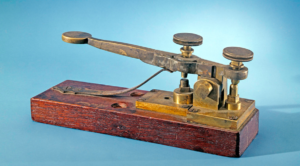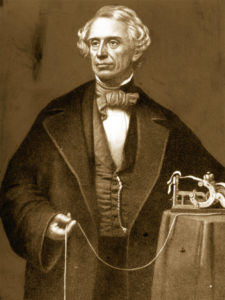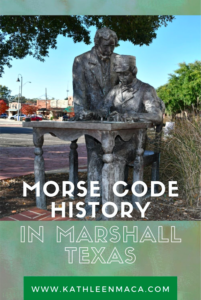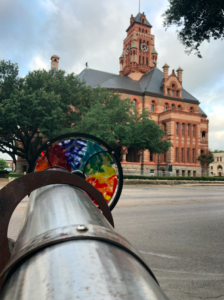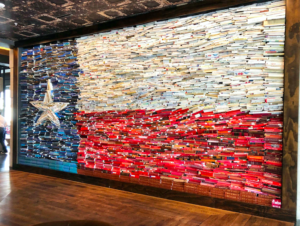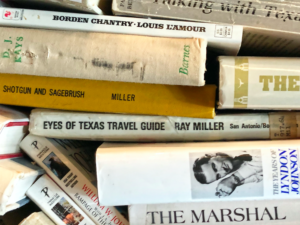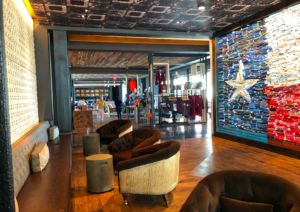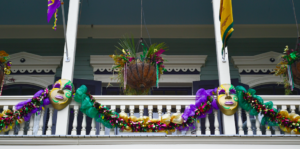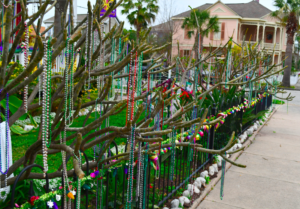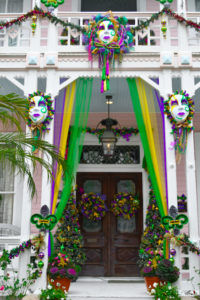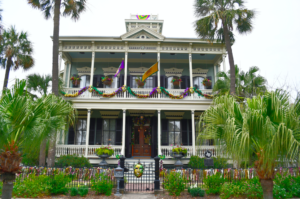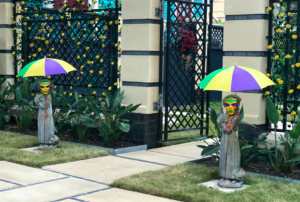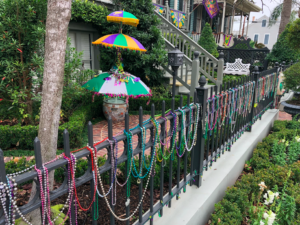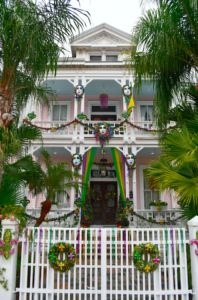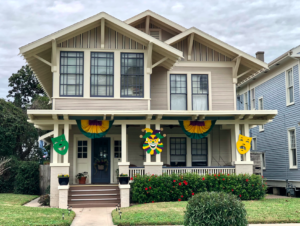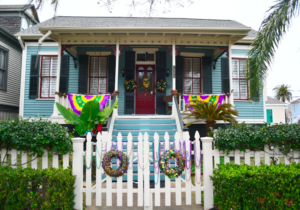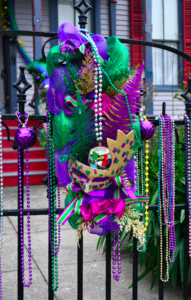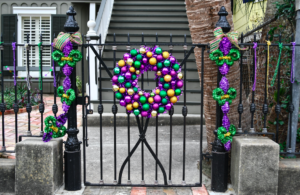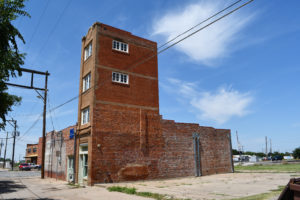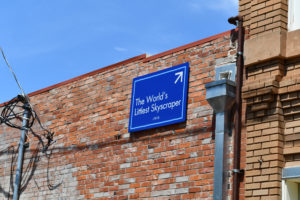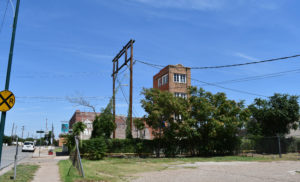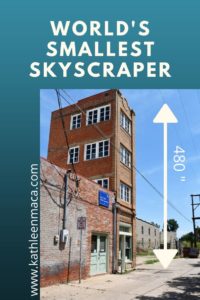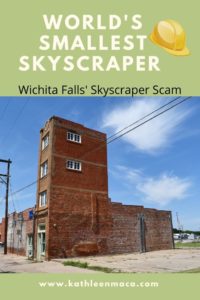Category: Texas
Searching for Outlaws in Sanderson
Have you ever search for an outlaw while on a vacation? They can be found in the most unexpected places, and it might not be as dangerous as it sounds.
If you recognize this famous photo, you might just be an Old West enthusiast like I am! It’s Butch Cassidy (bottom right), the Sundance Kid (bottom left) and the Wild Bunch, and is known as the “Fort Worth Five” photo.
That fellow sitting in the middle – known as “The Tall Texan” – was the subject of my search in Sanderson, Texas. He was a handsome guy, but didn’t always make good choices.
Ben Kilpatrick was born just east of San Angelo in 1874. He worked as a cowboy for several years before he became acquainted with Texas outlaws Sam and Tom Ketchum, and ended up riding with the Ketchum Gang.
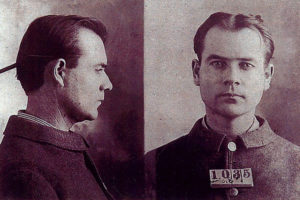 After a failed train robbery that ended in several of the members being caught, Kilpatrick fled to Robber’s Roost in Utah and joined the Wild Bunch. After some success, he and his girlfriend Laura Bullion made their way to St, Louis where they were arrested. Kilpatrick was seated to 15 years in prison for robbery, and Laura was sentence to five. After serving 31/2 years she was released, and went to Tennessee under an assumed name to make a new life.
After a failed train robbery that ended in several of the members being caught, Kilpatrick fled to Robber’s Roost in Utah and joined the Wild Bunch. After some success, he and his girlfriend Laura Bullion made their way to St, Louis where they were arrested. Kilpatrick was seated to 15 years in prison for robbery, and Laura was sentence to five. After serving 31/2 years she was released, and went to Tennessee under an assumed name to make a new life.
Kilpatrick, on the other hand, was released after 10 years and went immediately back to a life of crime. Bad decision…
Train number 7 of the Galveston, Harrisburg & San Antonio Railroad pulled out of Del Rio on the evening of March 12, 1912. It made a brief stop for water in Dryden, but as it pulled away from the station Kilpatrick and Ole Hobek ( a friend from his prison days) jumped aboard.
The masked robbers ordered the engineer to go to the first iron bridge east of Baxter’s Curve, about halfway to Sanderson. Once there the bandits ordered the train to stop and the passenger cars and caboose uncoupled from the engine, mail and baggage cars.
Leaving the passengers behind, they ordered the engine across the bridge and about a mile down the tracks, where the robbers had staged horses for their getaway.
Hobek kept a gun on the engineer while Kilpatrick went back to the baggage car with Wells Fargo Express agent David Trousdale. As they were making their way to the back of the car, Trousdale picked up a mallet from a shipment of frozen oysters and hid it in his clothing. (Frozen oysters…who would have thought THAT would be on the train?!)
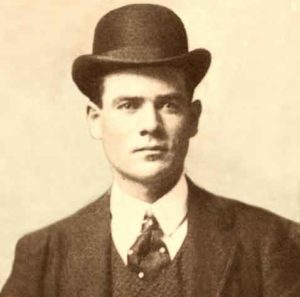 Kilpatrick was so busy filling a bag with $60,000 he didn’t see Trousdale sneak up to hit him over the head with the mallet. (Ouch!) The outlaw was killed with the one blow. Trousdale took the bandit’s gun and returned to the engine where he shot and killed Hobek just after midnight.
Kilpatrick was so busy filling a bag with $60,000 he didn’t see Trousdale sneak up to hit him over the head with the mallet. (Ouch!) The outlaw was killed with the one blow. Trousdale took the bandit’s gun and returned to the engine where he shot and killed Hobek just after midnight.
With the threat ended, the engineer backed up the train, re-coupled the passenger cars and proceeded to Sanderson.
The dead train robbers were held up for photographs, and later buried in a joint grave at Cedar Grove Cemetery in Sanderson. Trousdale, of course, was rewarded for his bravery.
Now known as the Baxter’s Curve Train Robbery (or the Sanderson Train Robbery), it was one of the last train robberies in the state.
In 2019, the mallet used in the incident, a photo of the dead bandits and the Wells Fargo accounts were sold at auction in Arizona for $64,900. It’s a bit ironic how close that amount is to the amount that the robber’s might have gotten away with, had there not been a quick thinking agent on board.
The train robbers’ grave was fairly easy to locate, surrounded by a decorative wrought iron fence and gate. The concrete slab that covers the plot was most likely poured in an effort to prevent gruesome souvenir hunters from robbing the grave.
As a taphophile, or someone who studies cemeteries, I’m always amazed at the stories that lie behind the stones if you only take time to investigate!
Ozona – The Biggest Little Town in the World
Biggest little town in the world, indeed!
Ozona is the only community in Crockett County which is the size of Delaware. Yep, the only one! It’s about an hour southwest of San Angelo, 398 miles from Houston and 347 miles from El Paso. Which makes it a pretty good jumping-off point for a lot of directions.
But before you zoom through, consider stopping for some of the unique things that Ozona has to offer. We scheduled an extra night on our trip to Big Bend to give us time to wander around and explore . . .and to give the ol’ accelerator-foot a break.


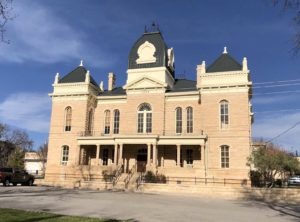
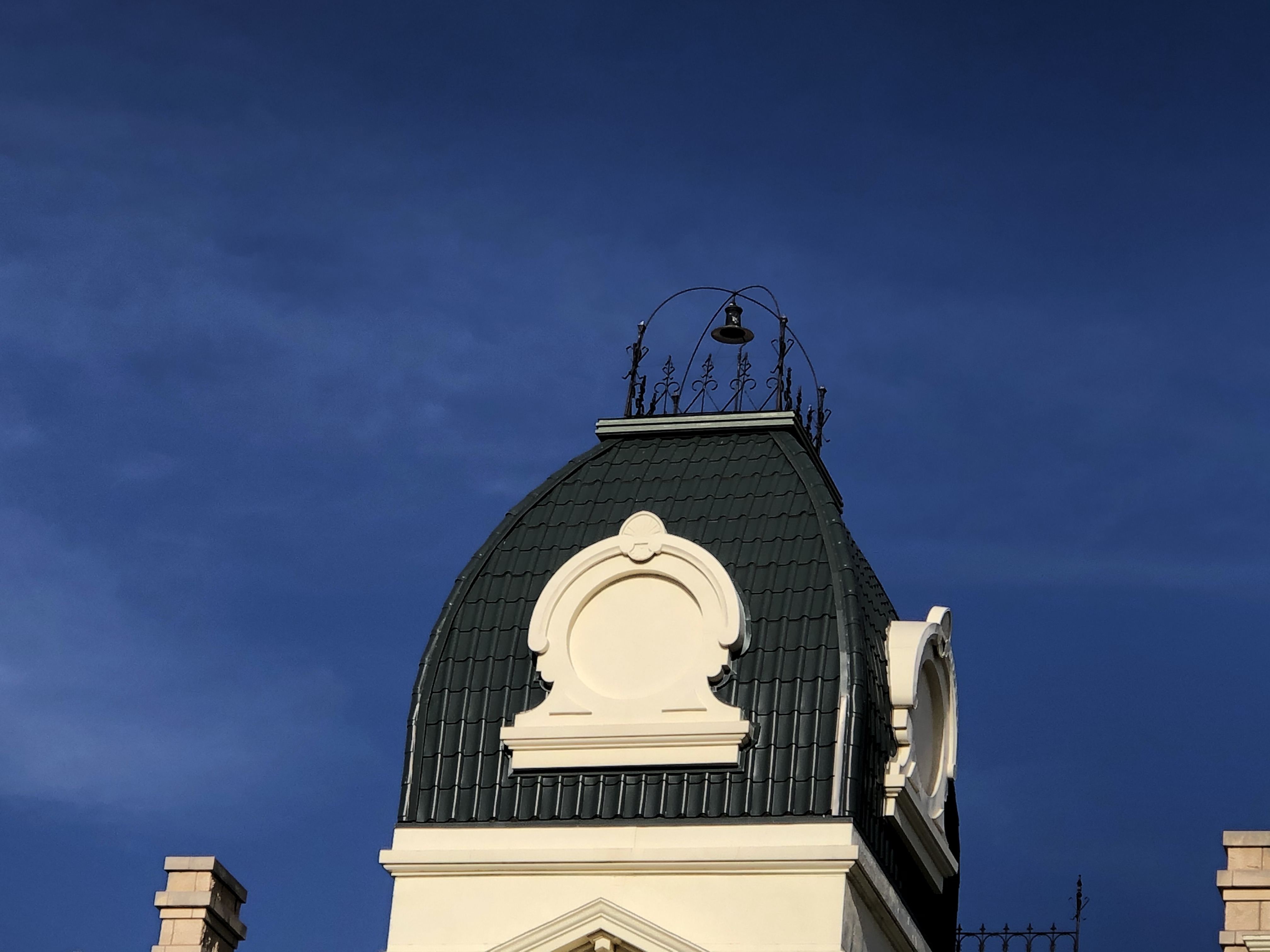



If you follow my blog or instagram account, you’ve probably figured out by now that I’m a sucker for historic courthouse buildings. I was happy to finally see this one in person.
The 1902 Second Empire courthouse of Crockett County – named after the legendary Davy Crockett – is the centerpiece of town. Designed by Oscar Ruffini, one of a pair of proliferate brother architects who kept busy populating Texas with their creations. Oscar also designed the Sutton County Courthouse, Tom Green County Courthouse and Ozona High School, and his brother Frederick Ernst designed the Concho County Courthouse, Bastrop County Courthouse, former Blanco County Courthouse (now restored) and the Millet Opera House in Austin.
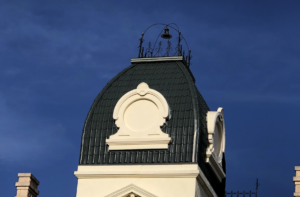 The courthouse was made from stone quarried on nearby property owned by the Crouch and Meyer families, and cost a whopping $30,000. In 1909 an arc light was added to the steeple to signal the sheriff (the Batman beacon comes to mind!) and guide travelers to town.
The courthouse was made from stone quarried on nearby property owned by the Crouch and Meyer families, and cost a whopping $30,000. In 1909 an arc light was added to the steeple to signal the sheriff (the Batman beacon comes to mind!) and guide travelers to town.
It was far more than a courthouse for Ozona and surrounding communities though, and served as a social center for cowboy dances, roundup celebrations, Christmas trees and box suppers (which reminds me of a particular scene from the musical Oklahoma!).
If the bull’s eye or “ox eye” circular moldings the mansard roof look like they’re missing something…they are! They were originally intended as a place for clock faces that were never installed. At one point in the past it bothered the locals enough to paint clocks in the features. When the courthouse was recently restored it was decided to leave them as is.
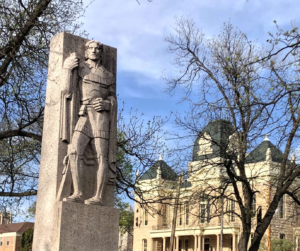 A memorial statue of Davy Crockett stands nearby on the square. Placed on its base in 1938, it was carved from two slabs of granite weighing nearly 20 tons (well, after all – he WAS a heavyweight of Texas history!), and is inscribed with Crockett’s motto, “Be sure you are right, then go ahead.” Still seems like sound advice.
A memorial statue of Davy Crockett stands nearby on the square. Placed on its base in 1938, it was carved from two slabs of granite weighing nearly 20 tons (well, after all – he WAS a heavyweight of Texas history!), and is inscribed with Crockett’s motto, “Be sure you are right, then go ahead.” Still seems like sound advice.
“The Tie that Binds” is an emotional bronze stands at the center of the square just a few strides away from Davy to remind visitors of the perseverance of their pioneer ancestors. At life-and-a-quarter size, it makes quite an impression close up!
Just across the street is the former Hotel Ozona (not to be confused with the former Ozona Hotel . . . th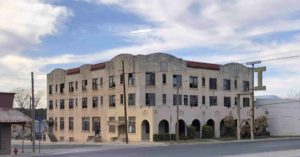 ey could have used a bit more imagination, evidently). The three-story mission style inn was built in 1927 to attract tourists along the Old Spanish Trail. See more of my photos of this abandoned beauty and find out more about the OST here.
ey could have used a bit more imagination, evidently). The three-story mission style inn was built in 1927 to attract tourists along the Old Spanish Trail. See more of my photos of this abandoned beauty and find out more about the OST here.
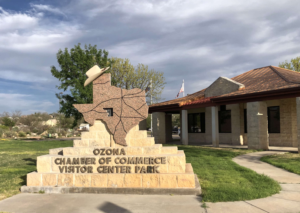
I really appreciate visitors centers that are more than a room filled with pamphlets, and the Ozona Chamber of Commerce and Visitor Center (505 15th Street) is definitely worth a stop (even if it’s just to see this cocky granite Texas sporting a Stetson). The building is bright and welcoming, and the staff are versed in numerous local and area attractions that might peak your interest.
Across the parking lot is the Crockett County Interpretive Trail (free to visit) showcasing native plants that can b e found within 100 miles of Ozona. The short trail (like a small park) has over 200 plants representing over 75 species, each identified b
e found within 100 miles of Ozona. The short trail (like a small park) has over 200 plants representing over 75 species, each identified b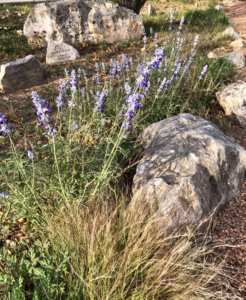 y an inscribed stone. We were lucky to stop by in spring when several of the plants were showing off their blooms, but the display would be fascinating year round. Botanists and gardening fans will get a kick out of this detailed brochure of the exhibit.
y an inscribed stone. We were lucky to stop by in spring when several of the plants were showing off their blooms, but the display would be fascinating year round. Botanists and gardening fans will get a kick out of this detailed brochure of the exhibit.
Off-roaders will definitely want to venture out to the Escondido Draw Recreational Area, a 3,500 acre, 110 mile trail for all-terrain vehicles, dirt bikes and 4-wheel drives.
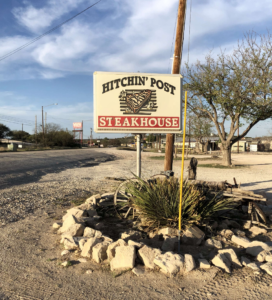 After driving all day and seeing a bit of town, we were ready to sit down for a good meal, the The Hitching Post Steakhouse (1301 Old Highway 290) came highly recommended. Actually, on some days of the week like we arrived on it’s pretty much the only game in town, but that’s just fine.
After driving all day and seeing a bit of town, we were ready to sit down for a good meal, the The Hitching Post Steakhouse (1301 Old Highway 290) came highly recommended. Actually, on some days of the week like we arrived on it’s pretty much the only game in town, but that’s just fine.
We were a bit confused when we pulled into the parking lot filled with at least two dozen fire trucks and resc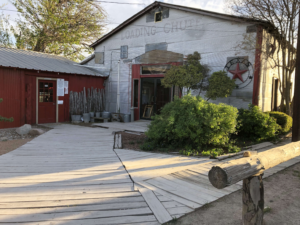 ue vehicles from all over Texas until we realized there was a firemen’s convention in town. But we definitely took that as a good sign, because let’s be honest – firemen know their food!
ue vehicles from all over Texas until we realized there was a firemen’s convention in town. But we definitely took that as a good sign, because let’s be honest – firemen know their food!
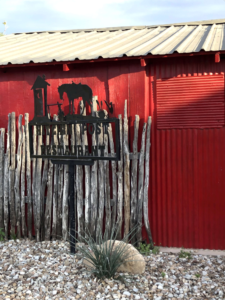 The western theme, come-as-you-are restaurant probably hasn’t been redecorated much in the last few decades, which the faded photos of Old West Outlaws and cowhide on the wall, heavy wooden club chairs and indoor/outdoor carpeting will attest to – but you won’t care a bit once your food arrives. If you’re looking for good food at reasonable prices, The Hitching Post fits the bill.
The western theme, come-as-you-are restaurant probably hasn’t been redecorated much in the last few decades, which the faded photos of Old West Outlaws and cowhide on the wall, heavy wooden club chairs and indoor/outdoor carpeting will attest to – but you won’t care a bit once your food arrives. If you’re looking for good food at reasonable prices, The Hitching Post fits the bill.
A smoking room on one side has pool tables and the bar, and the other side of the building has non-smoking seating. An outdoor patio is also a good option for dining on fair weather days.
Thirsty for something stronger than tea? Be forewarned that the restaurant charges a $5 club fee to “join” to order alcohol.
 Since we hadn’t worked up big appetites we decided to split a couple of appetizers, and settled on marinated cube steaks and 1/2 order of fried mushrooms. The portions were generous and deliciously seasoned. Thank heaven the waitress suggested we choose a half order of mushrooms, since a full order would have fed half the firemen in the room.
Since we hadn’t worked up big appetites we decided to split a couple of appetizers, and settled on marinated cube steaks and 1/2 order of fried mushrooms. The portions were generous and deliciously seasoned. Thank heaven the waitress suggested we choose a half order of mushrooms, since a full order would have fed half the firemen in the room.
I’ll definitely go back to try the chicken fried steak next time I’m in town. The fact that they’re open until 11 p.m. makes it easy if one of your day trips from Ozona runs a bit longer than expected.
If you have a bit more time during your visit to Ozona, you might want to explore:
-
Crockett County Museum
-
Fort Lancaster State Historic Site in Sheffield
-
Caverns of Sonora (34 miles)
Accommodations: We enjoyed our stay at the Holiday Inn Express Hotels & Suites. The staff was friendly and the rooms were lovely and clean. Just be aware that if you’re booking because you find a great rate, there might be unexpected charged added at checkout. Our $111 rate (which was one of the selling points that helped us decide to make Ozona a stop)— ended up costing about $165 which is a heck of a difference and more expensive than any of the other stays on our 10-day trip!
Hotel Ozona- Nothing But Vacancies
While taking photos of the county courthouse in Ozona, I turned around to see the remains of Hotel Ozona, and couldn’t resist getting a closer look. Obviously once a beautiful hotel and it was easy to imagine it surrounded by cars and people carrying in their finest leather luggage for a stay along a road trip adventure.
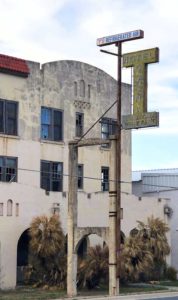 Ozona is a fairly small town, but its position along the Old Spanish Trail would have brought a lot of visitors a few decades ago.
Ozona is a fairly small town, but its position along the Old Spanish Trail would have brought a lot of visitors a few decades ago.
The Old Spanish Trail (also known as OST to many Texans), was a 2,750 mile long roadway that reached from ocean to ocean – St. Augustine, Florida to San Diego California. The headquarters for the project was in San Antonio, where an executive committee of prominent businessmen met weekly at the Gunter Hotel from 1915 until it was completed in the 1920s.
Perfectly timed for a nation that was enjoying a newfound enjoyment of “auto touring,” hotels and restaurants began appearing long the route just as they did later on Route 66. If traveled from one end to the other, tourists would cross eight states and 67 counties along the Southern United States!
Although promoters for the OST claimed that it followed the route used by Spanish Conquistadors 400 years earlier, there wasn’t actually a continuous trail from Florida to California that long ago.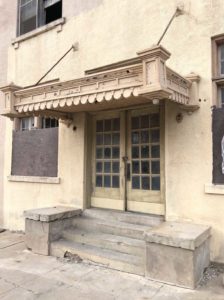
The three-story Hotel Ozona was built in 1927 for $150,000 from reinforce concrete, hollow tile and stucco, to provide stylish accommodations for the influx of tourists coming through the area. The hotel was a busy center of social life for the community for the next twenty years as well, hosting conventions, luncheons, bridge clubs, organization meetings. wedding receptions and more. The Comanche Ramblers, Fort Stockton’s string band, played for old time dances in the ballroom.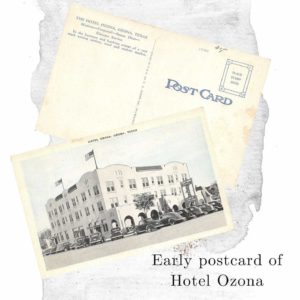
But the party didn’t last forever. In 1948 notices appeared in Texas newspapers advertising the 41-room hotel and its newly equipped kitchen for sale for a mere $8,500, due to the dissolution of a partnership. Travelers along the OST lightened in favor of other, newer highways resulting in many of the once-thriving businesses along its path to close down.
For whatever reason, the Hotel Ozona closed its doors, and never reopened. A peek in the few windows that aren’t boarded up don’t reveal many distinctively original design features other than the from desk, stairway and wrought iron railings.
The old neon sign touting air-conditioned rooms still stands tall, minus most of the neon. 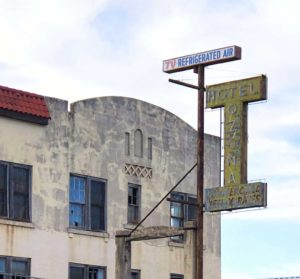
So she sits and wait for someone to come to her rescue. With the revival of so many older properties in recent years, I’m crossing my fingers that her patience will pay off.
Does Bigfoot Hang Out in East Texas?
For my 11th birthday, my parents took a group of my friends and I to see a new movie: “The Legend of Boggy Creek- A True Story.”
If you need a good giggle, click here to see the original movie trailer.
It was a new scary movie (called a docu-drama) about a monster that lived in the swamps of Arkansas. (I know, I know…”swamps in Arkansas?”) Basically portrayed as a Bigfoot-like creature, this guy attacked and killed people. I remember not being very scared (even back then it took quite a bit to scare me), but my friends screamed and clutched each other through the entire thing. I don’t remember if I noticed that it was painfully obvious that this “Bigfoot” was a guy in an ape suit, complete with cutout eyes.
But as bad as it was, the movie holds a fun spot in my memories because, hey…it was my birthday.
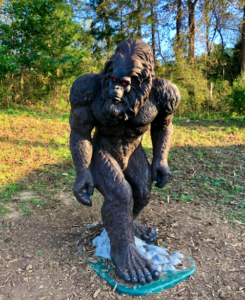 Just a few months ago I was speaking at a paranormal convention in Jefferson (about Victorian funeral customs). One of the gentlemen who had a booth in the vendor hall carried just about everything Bigfoot-themed you could think of: dolls, bumper stickers, books, key chains and more. I resisted as long as I could, but I finally politely asked him what connection Bigfoot had with East Texas.
Just a few months ago I was speaking at a paranormal convention in Jefferson (about Victorian funeral customs). One of the gentlemen who had a booth in the vendor hall carried just about everything Bigfoot-themed you could think of: dolls, bumper stickers, books, key chains and more. I resisted as long as I could, but I finally politely asked him what connection Bigfoot had with East Texas.
He looked at me as if I had lost my mind, and then asked if I had ever heard of a movie called “Legend of Boggy Creek.”
I smiled and replied that, well yes as a matter of fact I remembered that movie.
That’s when he told me that although the movie was set in Arkansas, those events actually happened in East Texas, where Bigfoot has been seen for years.
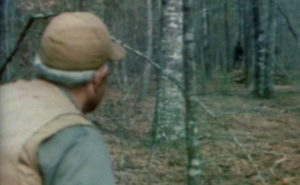 A couple of other attendees gathered to tell me that OF COURSE it was about East Texas, and the movie had even been filmed there.
A couple of other attendees gathered to tell me that OF COURSE it was about East Texas, and the movie had even been filmed there.
Well, huh. Who knew?
I thanked them for the information, and sat myself down for a visit with Mr. Google. But all I really had to do was walk across the street from the convention area to see a bronze statue of Bigfoot.
The next day, I drove to Uncertain, which is appropriately named for anything spooky, and recognized the same type of swampy, cypress-filled waterways and run-down wooden shacks that appeared in the movie.
I didn’t get to meet Bigfoot, but maybe he rests during the day. Wherever he was, I found Uncertain to be a magical place, and can’t wait to visit again to go kayaking or on an airboat ride. It’s an ecological wonderland. But I’ll have to remember to keep an eye out for the Big Guy in the treeline.
Who wants to join me?
Dots and Dashes: Telegraph in Marshall
_ . _.._ ._ …
If it looks like I just accidently hit some random keys while beginning to type this, morse code might not be in your wheelhouse. The mysterious string of dots and dashes spells out the name of a place I love: Texas!
On 100 block of North Washington street in Marshall, facing their enormous courthouse, this life size bronze statue reminds passersby that the town holds a unique place in communication history. It sits on the spot where the first telegraph office in the state opened in February 14, 1854. Long-distance communication w-a-y before cellphones and emails made it something that we take for granted.
The Texas and Red River Company opened its Marshall office and strung wires all the way to Shreveport, which in turn had wires to New Orleans. By 1854 another line connected the town to Houston via other lines. That opened up a lot of business opportunities for the railroad town.
By 1870 there were about 1,500 miles of telegraph wire across the Lone Star State. Instead of riders on horseback an stagecoach carrying 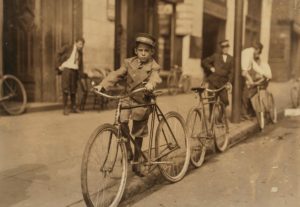 handwritten messages for days, a series of sounds could be translated into words and handed to messenger boys as young as 10 years old who would deliver the messages on their bikes within minutes.
handwritten messages for days, a series of sounds could be translated into words and handed to messenger boys as young as 10 years old who would deliver the messages on their bikes within minutes.
Now here’s the part that’ll leave you scratching your head…
In 1838, Samuel F. B. Morse (the inventor of the telegraph) wrote a letter to Memucan Hunt. Hunt was a friend of Morse’s who just happened to be the Republic of Texas minister to the United States who had told the inventor countless stories about Texas. He had explained that although the republic had lots of land and heart…it was a bit short on revenue.
In the letter, Morse offered the answer to that problem by GIVING the rights to his incredible invention to Texas. Um, WHAT?!
 Somehow the letter, which had been forwarded to officials of the republic, ended up filed away, gathering dust.
Somehow the letter, which had been forwarded to officials of the republic, ended up filed away, gathering dust.
Y-e-a-r-s later in 1860, Morse wrote a follow up letter to Texas Governor Sam Houston.
“In the year 1838 I made an offer of gift of my invention of the Electro magnetic Telegraph to Texas … Although the offer was made more than twenty years ago, Texas … has never directly or impliedly accepted the offer. I am induced, therefore, to believe that in its condition as a gift it was of no value to the State … I, therefore, now respectfully withdraw the offer made then.”
Wow, talk about an opportunity falling through the cracks! Imagine how much money Texas could have made as the owner of that patent. Sigh…
So while this beautiful bronze statue reminds us of an immense accomplishment…there is definitely a “oops” factor attached!
Waxahachie’s Courthouse Square Kaleidoscope
Waxahachie courthouse Square kaleidoscope takes looking at the world through rose colored glasses one step further. The Internet active artwork created by Eddie and Mary Elizabeth Phillips sits on the corner of Main and College Street, just across the street from the fabulous Ellis County Courthouse. You overlook it if you’re as entranced with courthouse architecture as I am, but it’s worth looking for! It takes the cardboard kaleidoscopes of our youth to a while new level.
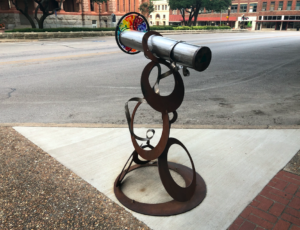 Built of scrap metal and stained glass, visitors can spin the glass wheel at one end and then look through the triangular opening at the other for a burst of ever changing colors. And the installation is near the corner streetlight it can even be enjoyed at night. (Good thinking!)
Built of scrap metal and stained glass, visitors can spin the glass wheel at one end and then look through the triangular opening at the other for a burst of ever changing colors. And the installation is near the corner streetlight it can even be enjoyed at night. (Good thinking!)
Click these links to see videos of this kinetic beauty in action, and then make a note to give it a spin yourself when you’re in the area!
Were you as fascinated with kaleidoscopes as a kid as I was?
Lone Star Book Art: Barbara Bush Wall at The George
Two of my favorite things: books and Texas!
As you walk into the doors of The George hotel in College Station, with first thing you’ll see is an enormous Texas flag. And boy does it make a Texas-size impact. Now walk over and take a closer look – it’s made entirely of books!
 That’s 10,000 books as a matter of fact, including works of fiction, non-fiction and even textbooks. Artist Thedra Cullar-Ledford spent months collecting books with red, white or blue spines from bookstores and thrift shops to create the floor to ceiling installation. Even more challenging, she included many Texas-centric subject matter like barbeque, agriculture and Texas biographies.
That’s 10,000 books as a matter of fact, including works of fiction, non-fiction and even textbooks. Artist Thedra Cullar-Ledford spent months collecting books with red, white or blue spines from bookstores and thrift shops to create the floor to ceiling installation. Even more challenging, she included many Texas-centric subject matter like barbeque, agriculture and Texas biographies.
It’s fun to get up close to see what titles you’ll find. I got a special kick out of the Eyes of Texas by Ray Miller- a book that was well loved in my home when I was growing up.
She then sorted them by color, nailed the books together, and screwed groups to the wall to create the pattern of the Lone Star flag.
It’s the most photographed spot in the Century Square complex.
The art piece was recently renamed in honor of former First Lady Barbara Bush as a symbol of her dedication to literacy – a touching tribute. Oh, and George W. Bush’s book “Decision Points” is among the books in the flag.
 Of course that isn’t where the hotel’s connection to the Bush family ends. The George, which was named for the great Georges in history, is just three miles from the George H. W. Bush Presidential Library and Museum. And the nearby Century Square restaurant is named Poppy, former president Bush’s boyhood nickname. If you’re a fan of the Today Show, you’ve probably heard Jenna Bush Hager refer to her famous grandfather by that name.
Of course that isn’t where the hotel’s connection to the Bush family ends. The George, which was named for the great Georges in history, is just three miles from the George H. W. Bush Presidential Library and Museum. And the nearby Century Square restaurant is named Poppy, former president Bush’s boyhood nickname. If you’re a fan of the Today Show, you’ve probably heard Jenna Bush Hager refer to her famous grandfather by that name.
The George, which is a property in the Valencia Hotel Group, has also instituted a “Round Up for Reading” program in which guests can donate any amount to the Barbara Bush Literacy Foundation. Ya gotta love a company that gives back to its community.
So next time you’re in College Station swing by The George (or better yet, stay there!) and see this impressive creation. Oh and…drop your spare change in the literacy foundation container at the front desk. You’ll come away with some great pics and feeling good about doing something nice for others at the same time.
Galveston’s Mardi Gras Houses
Looking for Mardi Gras festivities that are socially distant? Galveston Island has your answer.
Galveston Island has been celebrating Mardi Gras with citywide celebrations since 1871, and with private parties before that.
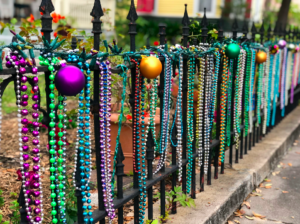 The town may be covered in sparkling lights for the Christmas season, but it bursts out in gold, green and purple for Mardi Gras. If you pass the houses at night and think you spot a Christmas tree inside a window, it’s most likely a Mardi Gras tree instead.
The town may be covered in sparkling lights for the Christmas season, but it bursts out in gold, green and purple for Mardi Gras. If you pass the houses at night and think you spot a Christmas tree inside a window, it’s most likely a Mardi Gras tree instead.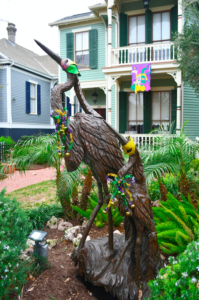

The annual parades have been cancelled this Carnival season for safety’s sake, but that won’t stop Galvestonians and their visitors from having fun. Taking a cue from New Orleans, instead of floats this year you’ll find “house floats” around the island.
Members of the Krewe of Saints who decorated their own homes complied a list of addresses so others can enjoy the fun. You can find an interactive map here.
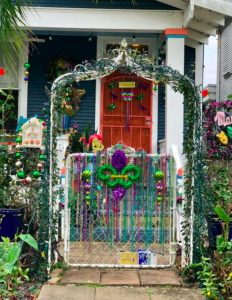 On Saturday, February 13th between 5 and 7 p.m., some of the participating houses will have beads and surprises for strolling revelers in their neighborhoods.
On Saturday, February 13th between 5 and 7 p.m., some of the participating houses will have beads and surprises for strolling revelers in their neighborhoods.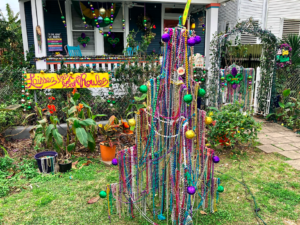
If you’re driving through the neighborhoods rather than walking, be aware that some of the streets are one way. There are often quite a few cars parked in front of the houses, making the streets narrower to navigate.
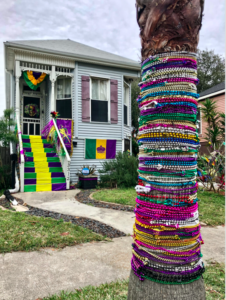 Of course, there are more homes decorated than the ones owned by this one Krewe, and the best way to see them all is to drive or walk the streets looking for the festive trimmings. If you only have a limited time, I would suggest exploring Sealy an Ball Avenues.
Of course, there are more homes decorated than the ones owned by this one Krewe, and the best way to see them all is to drive or walk the streets looking for the festive trimmings. If you only have a limited time, I would suggest exploring Sealy an Ball Avenues.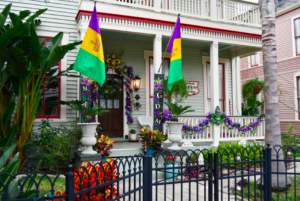
If you’re looking for some edible treats to keep up your Mardi Gras energy, you can find Mardi Gras bagels and cookies at Patty Cakes Bakery, king cakes at Maceo Spice Company and delicious seafood gumbo at the Black Pearl.
Have fun and Laissez les bon temps rouler!
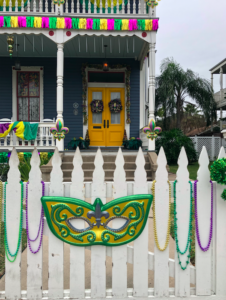
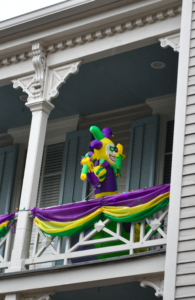
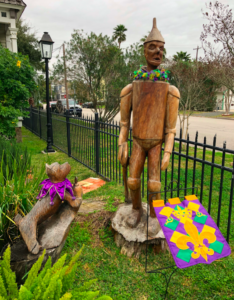
World’s Smallest Skyscraper: How a Con Man Gave Wichita Falls a Claim to Fame
How could a city invest a fortune in a “high-rise” that’s only about forty feet tall? This building’s tale should appear in the dictionary as the definition of “hoodwinked.”
In 1912, a large petroleum reservoir was discovered west of the city of Burkburnett, a small town just outside of Wichita Falls. Of course everyone was pretty happy about the financial windfall that ensued, but it also brought more people and businesses to town that wasn’t prepared to house them. People were so desperate that they were even conducting business in tents pitched on street corners. What Wichita Falls needed was more office space!
There was a one story building on the corner of Seventh and LaSalle Streets built by Augustus Newby in 1906 that was ideally located near the downtown railway depot. One of its tenants, J. D. McMahon, had a construction firm in there and say what he thought was a shining opportunity.
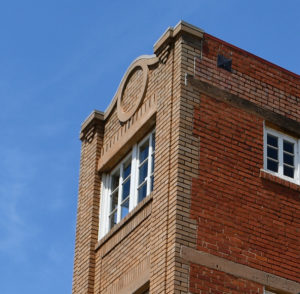 In 1919 he proposed to build a high-rise annex next to the Newby Building that would provide multiple floors of space for commerce to the boomtown. Sounds like a great idea, right? That’s what the city leaders thought, too.
In 1919 he proposed to build a high-rise annex next to the Newby Building that would provide multiple floors of space for commerce to the boomtown. Sounds like a great idea, right? That’s what the city leaders thought, too.
McMahon drew up impressive looking blueprints (though he wasn’t an architect) and showed them to potential investors, who forked over $200,000 in capital for the building’s construction. That’s the equivalent of $2.8 million in today’s money!
He proceeded with the construction of the skyscraper, but used his own construction crew to control and oversee the project.
Locals evidently turned their attention elsewhere as the building was being raised, because it was almost completed before they noticed that something was wrong. Their high-rise tower wasn’t what they had envisioned. Instead of the 480-foot structure thy expected; McMahon had built a 480-inch building.
The brick embarrassment was only eighteen feet deep, ten feet wide and each of the four floors had only 118 square feet of space on each of the four floors.
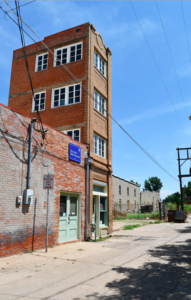 It’s been referred to as a glorified elevator shaft, which is especially ironic since the crew originally hired to install an elevator backed out of the project. The only way to access the upper floors was by an external ladder (until an interior staircase was built years later).
It’s been referred to as a glorified elevator shaft, which is especially ironic since the crew originally hired to install an elevator backed out of the project. The only way to access the upper floors was by an external ladder (until an interior staircase was built years later).
Infuriated investors took McMahon to court, sure that they would find justice for the con. But they had one more surprise in store.
Even though the judge was sympathetic to their complaints, he had to rule in favor of McMahon. What none of the financers had noticed in their excitement and rush to sign off on the project is that the blueprint listed the building’s dimensions in inches – not feet. It was build to the specifications proposed – 480” not 480’. Oh, the different an apostrophe makes!
The narrow stairs that were built a few years later took up twenty-five percent of the interior space, making it even smaller.
How could the situation possibly be worse? McMahon had never gotten permission from the property’s owner, who lived in Oklahoma, to build on the lot!
Needless to say, the Newby-McMahon Building was quite an embarrassment for local officials. The oil boom ended shortly after the building was completed, and it was boarded up and fell into disrepair.
Once the economy regained its footing, several small businesses operated in the snug spaces of the structure, including a barbershop and restaurants. It is now home to an antique shop on the bottom floor, and artist studios above.
Luckily, the building has survived several potentially fatal events including a fire, a 2003 tornado, and attempts by locals to have it demolished.
Wichita’s City County granted $25,000 in funds for the building’s restoration in 2005. Now, it’s true that that’s as much as it cost to build it in the first place – but that was a different time. Now the people of this Texas town have a reminder of the oil boom, a curiosity of visitors and something to point to and tell an amazing tale.
It might be difficult to spot from a distance because there’s more “sky” than “scraper,” but it’s worth stopping by to see this scam-tastic little piece of Texas history.

